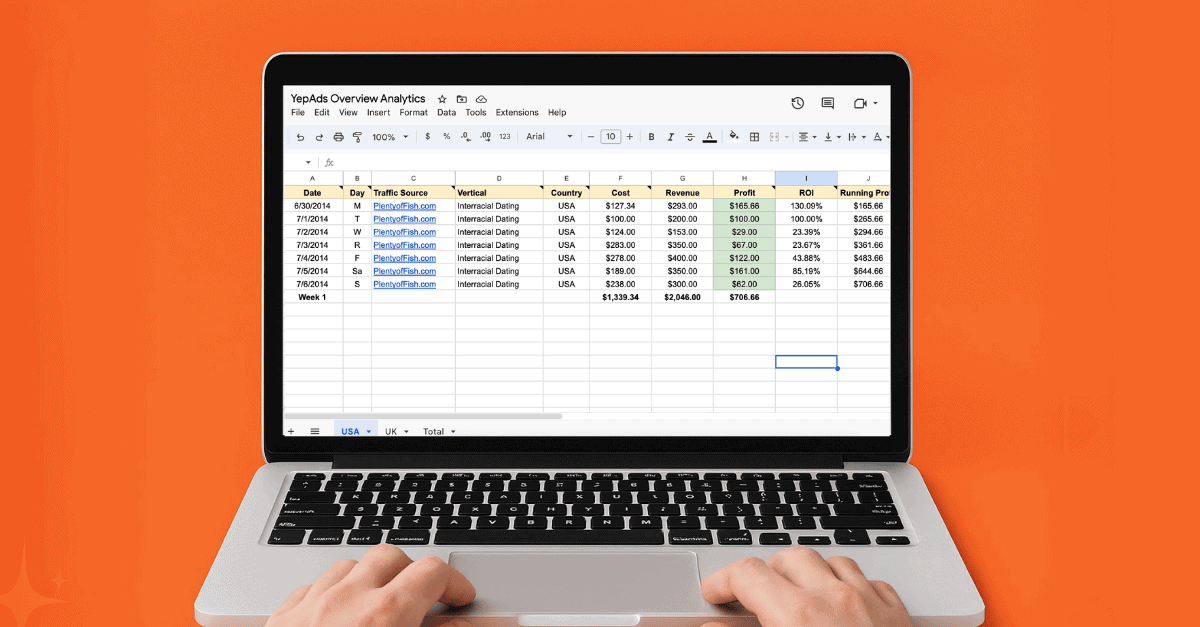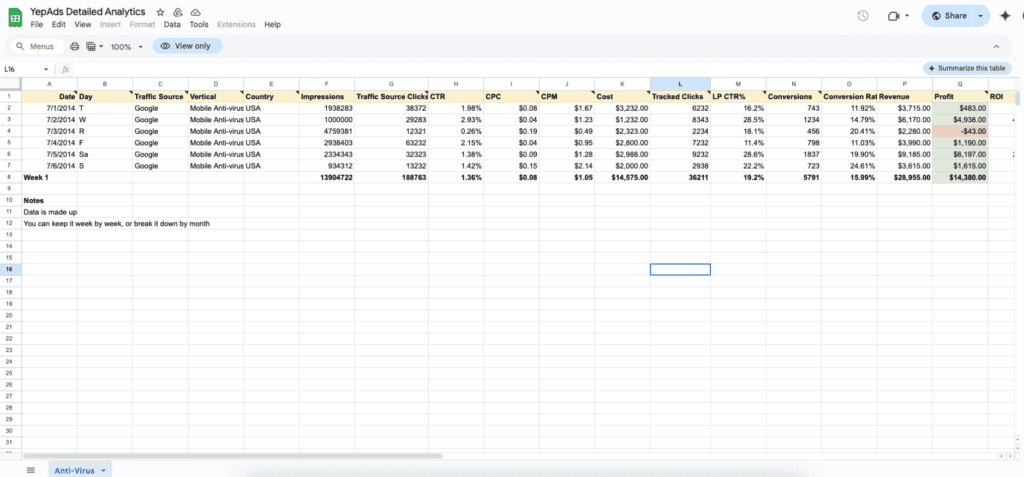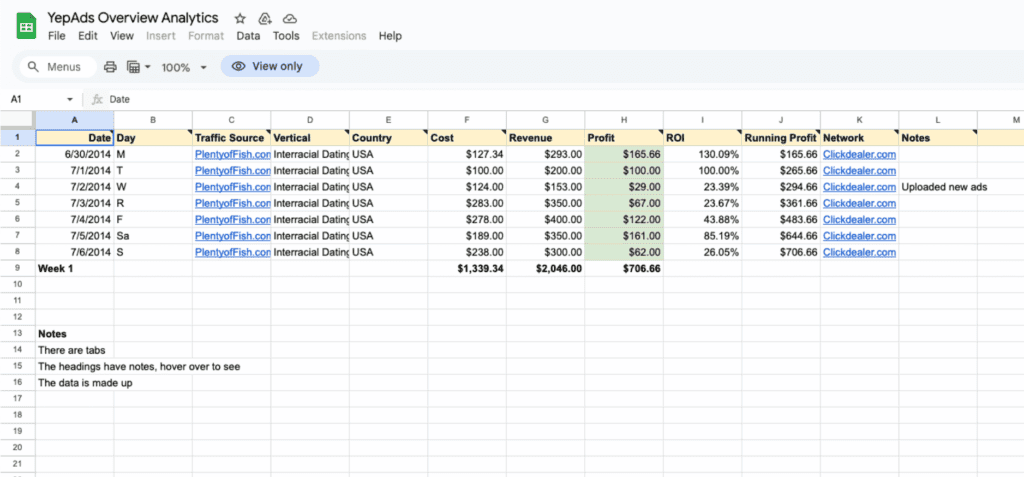
2 Free Templates to Track Your Daily Affiliate Revenue (2026 Edition)
If you’re serious about affiliate marketing, here’s a hard truth: you must know your numbers—every single day.
It’s surprising how many affiliates fail to track exactly how much they’re earning daily or weekly. And while tracker platforms give you a nice overview, they often rely on estimates—especially when it comes to cost data. That’s why manual tracking still matters.
Top-performing affiliates understand this. They treat their campaigns like real businesses, and that means having accurate profit records—down to the dollar.
Table of Contents
- Why Manual Tracking Is a Must
- Grab These 2 Free Templates
- Deep Analytics Template
- Profit Overview Template
- How to Make the Most of These Templates
- Should You Use Excel or Google Sheets?
- Other Tips for Smarter Tracking
- Align Your Time Zones
- Use Tabs to Stay Organized
- Track Multi-Source Traffic Clearly
- Final Thoughts
- FAQs on Affiliate Tracking
Key Takeaways
- Manual tracking gives affiliates exact profit data that trackers often miss.
- Spreadsheets provide full control, helping spot issues early and record performance history.
- Two free templates support different workflows: Deep Analytics for detail and Profit Overview for scale.
- Clean tracking habits (time zones, tabs, traffic source separation) lead to smarter optimization.
- Knowing your numbers daily builds confidence, avoids errors, and drives sustainable growth.
Why Manual Tracking Is a Must
Your tracker can’t tell the full story. It’s built for analysis, not exact accounting. If you’re sharing profits with team members or contractors, even small discrepancies in data can skew decisions and payouts.
Spreadsheets, on the other hand, offer complete control.
- You’ll know exactly what came in and what went out.
- You’ll spot issues before they cost you.
- You’ll build a real record of performance over time.
And when it comes time to re-launch a campaign or analyze past winners, these records become gold. Even if a platform switch wipes your old tracker data, your spreadsheet keeps everything intact—from profitable countries to top-performing traffic sources.
Grab These 2 Free Templates
To make life easier, we’re giving you two affiliate revenue templates to scale campaigns across multiple verticals.
1. Deep Analytics Template – For hands-on optimizers

Ideal if you’re running a few focused campaigns and want to understand the why behind the performance.
You’ll manually record:
- Clicks
- Cost per click
- Landing page metrics
- Revenue
- More…
Yes, it takes a bit more effort—but the insight you’ll gain is worth it. You’ll start noticing patterns and performance drivers that most affiliates miss.
Here are a few proven ways to boost profits:
- Lower CPC (higher ad CTR, buying traffic in bulk)
- Increase payout (negotiate with your affiliate manager, go direct)
- Boost offer conversion rate (better ad creatives, better targeting)
- Improve landing pages (stronger headlines, better images, clearer copy)
Remember: Your job is to drive down CPM and push up eCPM. This sheet will help you track exactly how.
Download the Deep Analytics Template
2. Profit Overview Template – For busy affiliates scaling fast

Running dozens of campaigns? This one’s for you.
Skip the deep breakdowns and focus solely on total daily profit. Use your tracker for analysis and this template for clear revenue snapshots.
It’s perfect for:
- Tracking overall profitability
- Managing multiple verticals
- Delegating reporting while keeping oversight
Download the Profit Overview Template
How to Make the Most of These Templates
If you’re serious about running high-performing campaigns, daily analytics should be non-negotiable. Set aside a few minutes each morning—set a timer if needed—to log and review your data. It may seem routine, but this small habit sets the tone for smarter decisions all day long.
Here’s why staying hands-on matters:
- Manually entering your data builds a deeper understanding. You start spotting patterns, changes, and insights that could be missed otherwise.
- It helps avoid costly mistakes.
Now, if you’re scaling and looking to streamline, automation is a smart next step. No errors, no delays. If you’re comfortable with code or have a tech partner, it’s worth exploring.
Bottom line: don’t hand off your vision. Stay close to your numbers, especially in the early hours. It’s one of the simplest ways to stay sharp, avoid surprises, and keep scaling with confidence.
Should you use Excel or Google Sheets?
Honestly, both get the job done. But if you’re working with a team, Google Sheets makes collaboration much smoother. It’s easy to share, and you can give view-only access so your teammates can stay in the loop without accidentally changing anything.
Other Tips:
If you’re serious about growing your affiliate campaigns, your first move should be cleaning up how you track and organize your data. A structured setup isn’t just helpful—it’s essential for making fast, strategic decisions with confidence.
Let’s break it down:
- Align Your Time Zones: If you’re operating in PST (Pacific Standard Time), your stats must be synchronized across platforms. Consistency avoids confusion—especially when you’re analyzing performance hour by hour.
- Most affiliate networks (especially those using CAKE) allow you to adjust the reporting time zone.
- Set everything to PST if that’s your working time zone, so you’re never second-guessing your results.
- Use Tabs to Stay Organized: Tabs can instantly make your data more manageable. They help you segment insights clearly without getting overwhelmed by noise.
You can use tabs to track:
- Different countries or GEOs
- Multiple traffic sources (e.g., Meta, TikTok, native)
- Separate verticals or niches you’re running offers in
Think of tabs as your custom-built filters—set them up in a way that helps you spot patterns and optimize faster.
- Track Multi-Source Traffic Clearly: It’s common to run traffic from more than one source to the same offer. That’s why it’s crucial to know exactly where your traffic is coming from.
- Assign unique tracking parameters to each source.
- Monitor how each one performs—what brings high-converting clicks vs. what drains your budget.
When you can pinpoint what’s working (and what’s not), you can scale winners faster and cut out the dead weight.
How would you separate the revenue from each traffic source?
If you’re scaling campaigns across multiple platforms, keeping your revenue data organized is key. The best affiliate marketers and media buyers don’t just look at overall profit—they break it down by traffic source to know what’s working and where to optimize.
Here’s how you can do the same.
Use SUBIDs (like SUBID3=PlentyofFish) to track each traffic source clearly. If you’d rather keep specific platforms hidden from your network, swap in coded labels instead. The goal is to identify performance without exposing sensitive info.
In most advanced setups, each major traffic source gets its own sheet. For example:
- Google Ads has its own document.
- Mobile traffic lives in one master file but with tabs separated by source.
- There’s also a master sheet that pulls everything together—profits, costs, ROI—so you always have the big picture.
Remember: this is your data, and the more intuitive it is, the faster you’ll spot trends and make smarter decisions.
Final Thoughts
If you don’t know your exact numbers, you’re flying blind. Every dollar earned (or lost) tells you something. The more precise your tracking, the faster you’ll learn—and grow.
Dialling in your tracking is the first step to unlocking real, scalable profitability. Treat it like the business it is, and you’ll be amazed at how far you can take it.
Want more done-for-you templates to help you grow faster?
Stick around—more’s on the way.
FAQs on Affiliate Tracking
Why can’t I just rely on a tracker?
Trackers are great for analysis but often rely on estimates, especially with cost data. Manual tracking ensures accuracy for profits, payouts, and revenue records.
Which is better for affiliates — Excel or Google Sheets?
Both work, but Google Sheets makes team collaboration easier and allows view-only access for partners. Excel is best if you prefer offline control.
How often should I update my tracking sheet?
Daily tracking is best. Even five minutes each morning helps spot trends, prevent errors, and set the tone for smarter campaign decisions.
Can manual tracking scale when running multiple campaigns?
Yes. With the Profit Overview Template and use of tabs or master sheets, affiliates can manage dozens of campaigns while keeping data organized.
What’s the benefit of using templates instead of my tracker?
Templates give you a permanent record of revenue and costs, even if a platform changes or wipes past data. They also help you analyze winners across GEOs, traffic sources, and verticals.
If you enjoyed this post, you might also like these articles we picked for you:
- How to Create an Affiliate Website in 2026
- What Is Affiliate Marketing? A 2026 Full Guide
- Performance Marketing vs Digital Marketing: Which One Drives Results?

Join as an Advertiser
Join as a Publisher
